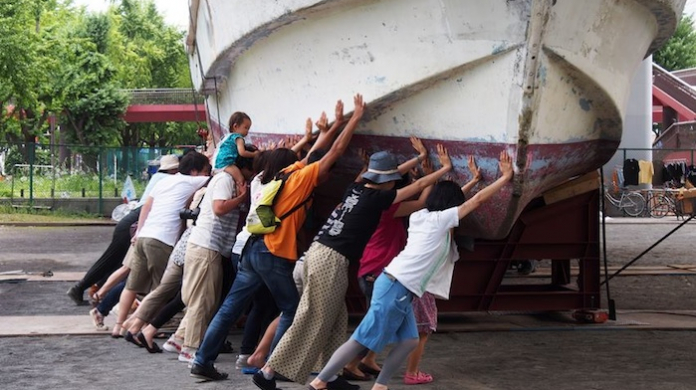Supported by the British Council, artists from Blast Theory visited Nagoya, Toyohama and Sendai in Japan. Here, artist and founder Ju Row Farr shares some of their experiences and tips.
Blast Theory blast off to Japan
Where did you go and what project were you involved in?
I visited Nagoya and Toyohama and last year Matt Adams visited Sendai in order to make The Thing I’ll Be Doing For The Rest Of My Life by Blast Theory.
How did the visit happen? Where did the idea come from and how did you find the opportunity?
Blast Theory was invited by Fumihiko Sumitomo to make a new piece of work for the Aichi Triennale in 2013.
What did the project involve?
In July 2013, Matt Adams wrote the following statement: "In the tsunami of 2011 the damage was so extreme that, at times, it seems like the laws of physics were overwhelmed. Yachts lay on bridges. Pleasure boats came to rest on the roofs of buildings. On a research trip to Kesennuma, I stood and gazed up at a 330 ton ship that had travelled half a mile inland.
In the hours after a major disaster it is the general public who are the heroes. Before the emergency services arrive, while the journalists are absent, men and woman who themselves have narrowly escaped harm save lives. They comfort the injured and dying. They distribute food and water. The usual systems of order and control may have been destroyed but people self-organise and take action.
I interviewed fishermen who had lived through the tsunami. They talked about the hours immediately after the disaster. They searched for relatives, they established shelters, they found food. And then they began the process of recovery. Mr Nakazato from Funakoshi told me about his work to continue the fishing tradition by training young people in his village. He looked to the future and said, 'This is the thing I’ll be doing for the rest of my life'.
The UK and Japan are both island nations with long and proud nautical traditions. So much so that the vessel is sometimes the symbol of the country itself. This work brings a crowd together to take a trawler – the Eight Prosper Circle – on a journey. With muscle power, communal strength and common purpose our friends will bring the boat to a new place.
What was the visit hoping to achieve?
Through visiting Japan three times, Blast Theory hoped to achieve an innovative and high-quality participatory or interactive artwork, in response to the thematic of the Aichi Triennale. To create a work from the perspective of British artists that looked at the abilities of ordinary people to achieve incredible things post disasters without the support or organisation of official parties.
What was the importance of your artform within the project?
What we hope is important is that we found artforms and methodologies in this project that fit hand in glove with the themes and concerns within the work itself.
What have you taught?
We didn’t do any official teaching in Japan but worked closely with assistants, and my hope is that some of the production of this work has passed on valuable experience for locating and building works of this complexity
What have you learnt?
Perhaps I didn’t learn this, rather I felt this, but there is a bottomless pit of potential and appetite in people for the need to gather and release something more that we all have to offer. Language is not a barrier; over protection of your position can be.
Outside the project, what did you see and do?
It is hard to describe all the various experiences I had outside and inside the work in Japan. It was such an incredibly rich and generous time that I was completely amazed by the whole opportunity. Some things that stand out for me are visiting the homes of people participating in the project.
I saw the full circle of events involved in the fishing communities of Toyohama – from building boats, to the catching and selling of fish, through to hospitality in the fishermen's homes, fish festivals celebrating the offerings from the sea and I enjoyed eating the fresh catch.
I went to the home of the Nomuras in Nagoya, a family who are considered national treasures – Kyogen Theatre has been in the family for 400 years and we worked with the son in our project.
I experienced eating rice grown locally in Japan by friends families and went to a Japanese tea house.
What one thing could the UK learn from the arts scene in Japan?
I think what strikes me is an attention to detail – both in terms of how people look after each other and how art work is treated at all stages – from a meeting to the execution of making. Everything seems very important, as it should be. It is of course impossible to generalise, but this impression of respect for materials, objects and people is very strong.
What was your most memorable moment?
Being told that this is going to happen, that Fumihiko had a faith in this project to work.
What was your most hair-raising moment?
Lifting a 30 tonne boat above our heads in the city centre in the middle of the night and looking at the webbing straps wondering how strong they are.
What are your suitcase essentials?
The external hard-drive for all the video and photographic back-ups.
What can’t you live without during your visit?
Water, sunscreen and a phone with some helpful people in the address book.
